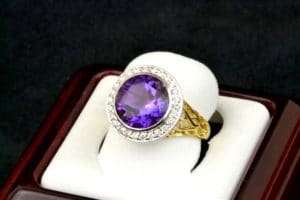
You’ve heard the terms “precious” and “semi-precious” used to describe different types of gemstones, but what do they really mean?
Diamonds are precious, so they must be worth more than semi-precious amethysts, right? Well, not necessarily.
There are a lot of factors that go into determining the relative worth of different stones, and those two confusing terms really have nothing to do with it.
Copeland Jewelers is here to set the record straight!
Precious vs Semi-Precious Gemstones
Believe it or not, “precious” and “semi-precious” are actually arbitrary terms when it comes to gemstones.
In fact, the U.S. Federal Trade Commission has discussed banning these descriptors so as not to confuse consumers. The terms were originally coined in the mid-1800s by jewelry executives who wanted to make certain stones seem more valuable than others and also denote that they were popular and rare.
The distinction between the two kinds of jewels is generally only used in the West.
What Stones Are Considered Precious?
Today, the only “precious” stones are:
- diamonds
- rubies
- sapphires
- emeralds
What Stones Are Considered Semi-Precious?
Opal, amethyst, and pearls were once classified as precious but are now categorized as semi-precious.
Other semi-precious stones include:
- turquoise
- topaz
- garnet
- citrine
- jade
- peridot
- jasper
- rose quartz
Materials used for jewelry that are not minerals, such as amber and jet, are also considered semi-precious stones.
In fact, the list of semi-precious gems is incredibly long and includes many materials you’ve probably never heard of, such as algodonite, hayune, euxenite, and chicken-blood stone, just to name a few.
Does the Classification of Precious or Semi-Precious Depend on Availability?
You might be thinking that the terms “precious” and “semi-precious” at least have something to do with how abundant the different gems are, or how easy they are to find, right? Nope!
Amethysts were downgraded once large deposits were discovered in South America in the nineteenth century.
Diamonds, however, kept their “precious” classification even after large deposits were discovered in South Africa, also in the nineteenth century.
The semi-precious gem tanzanite, however, can only be found in Tanzania and is much rarer than diamonds, emeralds, rubies, and sapphires. Alexandrites and tsavorite garnets are also very rare but considered “semi-precious.”
Many semi-precious stones of high-quality command much greater prices than medium-quality precious stones, so it’s truly all relative.
Is There a Different Way to Classify Gemstones That Isn’t so Confusing? Definitely.
Gemologists label them based on their physical features, such as the type of crystals that form the stones or the chemicals that compose them.
For example, diamonds are made of carbon. Gemstones are also categorized by their hardness, luster, specific gravity (a measure of density), dispersion and refractive index (measures of how light passes through the stones), and cleavage and fracture (patterns of the stones break).
These systems of classifying jewels are based in science and have merit beyond marketing purposes.
And once stones have been cut and polished, their worth is largely determined by the “four Cs”:
- color
- cut
- clarity
- carat
So Could Your Tiny Diamond Be Worth More Than Your Large Amethyst?
It’s impossible to measure the actual worth of either stone or piece of jewelry without being able to examine them in person.
Our suggestion, when it comes to choosing jewelry for yourself or someone else, is to focus on what you like (or what the recipient would like) rather than arbitrary terms that really have no meaning in the grand scheme of things.
It’s good to understand what “precious” and “semi-precious” refer to, but don’t use them as the main basis for your jewelry purchase.
Copeland Jewelers is pleased to educate our customers on the finer (and sometimes weirder) points of jewelry, but we’re mostly concerned with helping you choose a piece that will be treasured for years to come!
